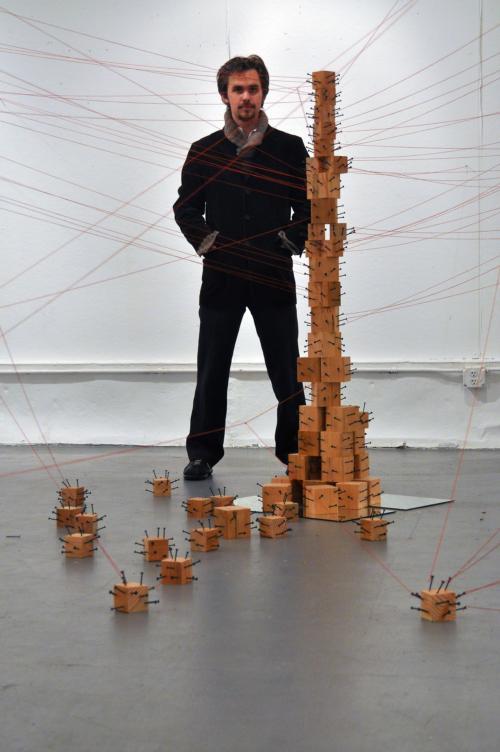
News
HMS Is Facing a Deficit. Under Trump, Some Fear It May Get Worse.

News
Cambridge Police Respond to Three Armed Robberies Over Holiday Weekend

News
What’s Next for Harvard’s Legacy of Slavery Initiative?

News
MassDOT Adds Unpopular Train Layover to Allston I-90 Project in Sudden Reversal

News
Denied Winter Campus Housing, International Students Scramble to Find Alternative Options
SPOTLIGHT: Trevor J. Martin '10

Strings extend across the Adams Art Space like lasers, both encouraging exploration of the space and prohibiting it. These boundaries present the artistic goals of Trevor J. Martin ’10 in his two-room exhibition “through/within/without”: to examine and problematize one’s physical and emotional situation.
Martin began studying art in high school, where he experimented with painting and digital media. In the fall of his freshman year at Harvard, he dove into the arts scene, contributing to a show for a class in the Visual and Environmental Studies Department with works of mixed media. He quickly realized that creating art was the only path for him, but one which can require a significant amount of initiative for a solo artist interested in creating larger-scale works.
While Martin praises Harvard’s willingness to support artistic projects, financing his projects have proved to be one of the most challenging aspects of pursuing art at the College. “This stuff is completely different from the other arts at Harvard. Look at it in relation to drama, for example. How do you fund a solo show? A student isn’t a club.” While he created the contents of “through/within/without/” for Taylor Davis’ Shapeshifting class, Martin had to purchase many of the work’s objects himself.
Martin avoids restricting himself to one medium. “I love to see the interplay of media, what different media evoke, and how they interact within a space,” he says. He is excited to be able to use the Adams Art Space for “through/within/without,” noting that it welcomes the artist. “It’s an old squash court, so it’s open, and you don’t have to be too aware of the architecture because it’s so neutral.”
While he is keenly aware of the need for deliberation in making art, Martin is intent on making the most of his time here. “If you are creating too quickly, you lose control; the art is not about communicating something to the world anymore.” With this in mind, he is planning his future as an artist one step at a time. He knows he has to make art, so he hopes to go on to get a Master of Fine Arts degree after graduating from Harvard, but is unsure about what will follow.
Andy Warhol is the artist whom he most admires, and in his own work Martin investigates some of the same questions that Warhol posed. “Warhol allows you to reappropriate images that you’re already embedded in, and by putting them into the medium of art he abstracts them so you can view them critically,” he says. “He explored how you can utilize the space created by art as a space for the fluid, a space to explore your own mind.”
In “through/within/without,” Martin also tried to process the mainstream media’s flood of images of conflict. “Because of the rate at which the media produces images, it’s amazing how unable we are to catch up with and challenge it. But those images compose our perception of the trauma of those conflicts.”
Sculpting in clay with photographs of war in front of him, he tried to extract all the emotion from the images and manifest it.
Want to keep up with breaking news? Subscribe to our email newsletter.
